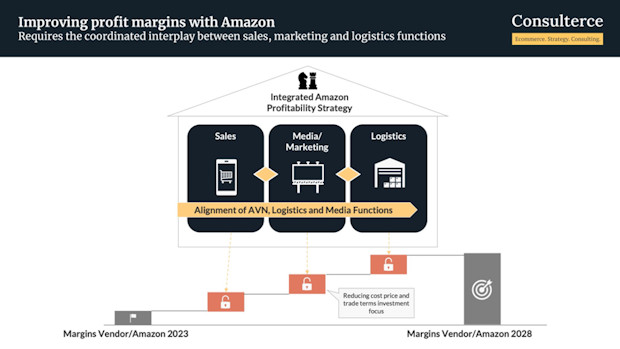By Martin Heubel, Amazon Strategy Consultant at Consulterce
Here’s the harsh truth: Your sales department cannot deliver your margin ambitions with Amazon.
Adding new products, negotiating better trade terms and raising cost prices will only increase your profits by a few basis points…if you’re lucky.
Brands that exceed their profitability targets with Amazon and successfully operate a 1P model have one thing in common.
They have effectively aligned the interplay of core functions necessary to win with the online retailer:
- Sales
- Finance
- Media/Marketing
- Logistics & Supply Chain
Let’s take a closer look:
1. Sales and finance teams create the framework
It’s true that your commercial teams will have the biggest influence on your success with Amazon 1P. However, trade negotiations will only be effective if commercial teams understand the entire customer P/L.
Brands that exceed margin benchmarks with the online retailer have clear and regular alignments between their sales and finance departments. They uncover hidden P/L cost centres from financial disputes, hidden charges, and other indirect expenses.
Most of all, your sales and finance teams should work together to define realistic ambitions for the customer account and review the resourcing needs inside your organization.
2. Media and marketing teams support margin ambitions
Most brands see Retail Media as a support function for growth.
This is problematic as it ignores the contribution of Retail Media to portfolio mix effects that can reinforce positive and negative profitability trends.
As more multinationals align their media investments with Amazon globally, there’s also an opportunity to align the JBP timelines between your sales and media departments.
After all, it makes no sense to grant Amazon Advertising a $10m cheque when your retail negotiations are escalating.
3. Supply chain teams tap into cost efficiences
One of the biggest advantages of Vendor Central is the ability to tap into cost-efficiency programmes offered by Amazon.
Vendor Flex, Full Truck Load Ordering, PICS, or a Direct Import model can significantly lower your vendor account’s variable cost structures.
Yet, most brands don’t consider the impact of an improved supply chain set-up as part of their annual negotiation preparation.
Those that do are usually rewarded by gaining clarity on the cost benefits of each model, enabling their sales teams to have more meaningful negotiations around cost savings from SCM initiatives.

For further information, contact Martin Heubel here




